ISSN ONLINE(2319-8753)PRINT(2347-6710)
ISSN ONLINE(2319-8753)PRINT(2347-6710)
Dr.S.M Gopinath1 ,Priyanka.P2, K.S.Dayananda3,Jagan Mohan Reddy4, Ashwini patil G.M5 Drishya V.Nair6
|
| Related article at Pubmed, Scholar Google |
Visit for more related articles at International Journal of Innovative Research in Science, Engineering and Technology
Diabetes Mellitus is a metabolic disorder characterized by high blood sugar level caused due to deficiency of insulin secretion or insulin action. One of the therapeutic approach to treat Type II Diabetes is to lower the postprandial blood glucose level by inhibition of carbohydrate hydrolyzing enzyme such as alpha-amylase. In present investigation polyherbal formulation (PHF) composed of 22 medicinal plants having anti-diabetic property were selected from WHO monographs and evaluated for in vitro alpha-amylase inhibitory activity. Air dried powders of 22 medicinal plants were divided into four categories. One formulation named as(PHF1) was used and prepared by mixing the powders in an optimized ratio of 80:10:5:5.Extracts of PHF1 prepared by soxhlet method using polar and non-polar solvent was subjected to Inhibition assay by using Dinitro salicylic acid (DNS) method and phytochemical constituents in the extract was analyzed qualitatively as well as by GC-MS.The results revealed the presence of glycosides, steroids, terpenoids, saponins, phenols and tannins. In vitro study indicates that PHF1 Hot water extract showed maximum percentage inhibitionof alphaamylase activity. This hot water extract of PHF1 can be effective in lowering postprandial hyperglycemia (PPHG).
Keywords |
| Type II Diabetes, Postprandial hyperglycemia (PPHG), Polyherbalformulation (PHF), Alpha-Amylase inhibition, Acarbose. |
INTRODUCTION |
| Diabetes Mellitus (DM) is a chronic metabolic disorder of multiple etiology characterized by chronic hyperglycemia with disturbances of carbohydrate, fat and protein metabolism resulting from defects in insulin secretion, insulin action or both [1]. There are many therapeutic strategies for the treatment of Type II Diabetes mellitus. Available therapies for treating type II diabetes include stimulation of endogenous insulin secretion, enhancement of action of insulin at target tissues and the inhibition of alpha-amylase enzyme to decrease the degradation of starch to reducing sugar. The drugs commonly used in clinic to handle or control diabetes are insulin, sulfonylureas, biguanide, glycosidase inhibitors, aldosereductase inhibitor, thiazolidinediones, carbamoylmethyl benzoic acid, insulin-like growth factor [2]. Antidyslipoproteineinemic agents as gemfibrozil and flavastatin are used [3].The α–amylase (α -1,4-glucan-4-glucanohydrolases; E.C. 3.2.1.1) is one of the major secretory products of the pancreas and salivary glands, playing a role in digestion of starch and glycogen and can be found in microorganisms, plants and higher organisms[4]. Alpha-Amylase enzyme catalyses the initial step in hydrolysis of starch to mixture of oligosaccharides consisting of maltose , maltotriose, and branched oligosaccharides of 6– 8 glucose units that contain both α-1,4 and α-1,6 linkages. These are further degraded to glucose by Alpha-Glycosidase which on absorption enters bloodstream. Rapid degradation of starch by Alpha-Amylase enzyme leads to elevated postprandial hyperglycemia (PPHG). Thus decreasing the degradation of starch to reducing sugar by inhibition of Alpha- Amylase enzyme plays a key role in control of diabetes.Inhibitors of pancreatic Alpha-Amylase prevent starch breakdown and absorption there by lowering post prandial glucose levels and also weight loss in humans [5, 6].Acarbose and miglitol which inhibit Alpha-Amylase and Alpha-Glucosidase are currently in clinical use. These synthetic drugs not only lower glucose level but also induce side effects and fail to treat diabetic complications. The main side effects of these synthetic drugs are abdotension, bloating, flatulence and diarrhea [7]. It has been suggested that such adverse effects might be caused by excessive inhibition of pancreatic Alpha-Amylase resulting in the abnormal bacterial fermentation of undigested carbohydrates in the colon [8].Therefore herbal medicines are gaining more importance in the treatment of diabetes as they are free from side effects and also less expensive when compared with synthetic drugs [9]. In India Ayurveda and other Indian traditional medicines have used plants for treatment of many diseases. Ethnobotanical studies of traditional herbal remedies used to treat diabetes have identified more than 1,200 species of plants with hypoglycemic property [10]. WHO (World Health Organization) has recommended the evaluation and medicinal properties of plants effective in such systems [11]. Screening natural sources such as medicinal plants can lead to potent and specific inhibitors for Alpha-Amylase therefore natural Alpha-Amylase inhibitors from the dietary plants can be used as effective therapy for post prandial hyperglycemia [12].Number of medicinal plants and their formulations are used for treating Diabetes in the traditional Indian Ayurvedic system. Major formulations used in Ayurveda are based on herbs used as decoctions, infusion, tinctures and powders. Drug formulation in Ayurveda is based on two principles: (a). Use as single drug, and (b). Use of more than two drugs. When two or more herbs are used in formulation they areknown as polyherbal formulation. It is evident that there are many herbal formulations of varying potency since these preparations act by different mechanism.Thus selected medicinal plants were subjected to solvent extraction and the resulting extracts were evaluated for their porcine pancreatic Alpha- Amylase inhibitory potential, screened for the presence of amylase inhibitors under invitro conditions by performing GC-MS and the extracts were subjected to phytochemical analysis in order to identify the probable inhibitory phytoconstituents. |
MATERIAL AND METHODS |
| Chemicals such as soluble starch, isopropanol, methyl-butyl-tertiary ether, petroleum ether, chloroform, and ethanol were of Analytical grade.PPA (Porcine pancreatic alpha amylase), starch and Acarbose was purchased from Sigma Aldrich USA. |
| Plant material |
| Anti-diabetic medicinal plants that are used were selected from WHO monographs. Powders used are of high quality and proved to have anti-diabetic property. Out of twenty two medicinal plant powders fifteen powders were purchased from nearby local market and remaining seven medicinal plant material (fenugreek, Tinospora cardio folia, curry leaves, stevia, onion, garlic and ginger) were air dried for 25 days after complete drying each plant material were finely crushed, powdered and stored in brown bottle. Plant material used are shown in table 1. |
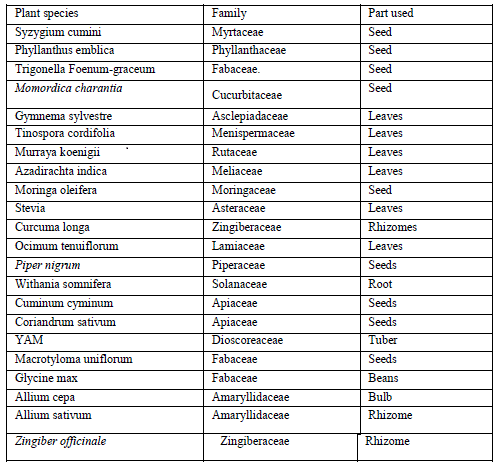 |
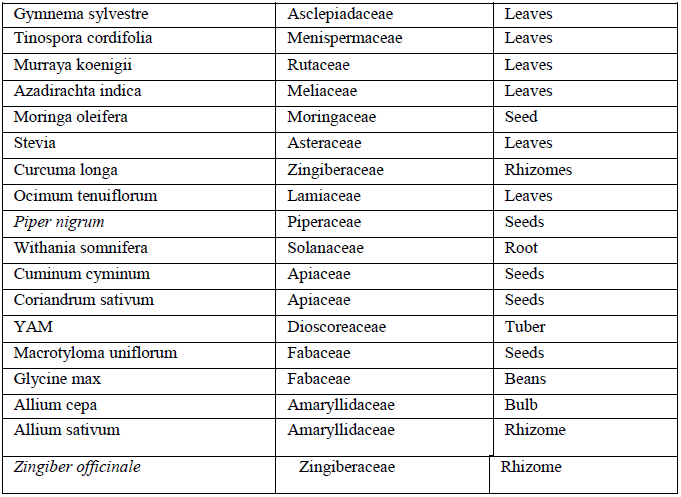 |
| Preparation of polyherbal formulation |
| Medicinal Powders were first divided into four categories as powders having major antidiabetic property, medium antidiabetic, hepatoprotective and anticholesteremic property. One polyherbal formulations (PHF1 ) was used and prepared by mixing the powders of above said categories in the ratio 80:10:5:5.Details of formulation is given in Table 2 . Air dried plant material was crushed, powdered and bioactive compounds from powders were extracted using soxhlet apparatus with polar and non polar solvent. The solvent used were hot water, cold water, ethanol, isopropanol, petroleum ether, methylbutyl- tertiary ether and chloroform. Cold water extracts (PHF1) was obtained by adding distilled water to the crushed material in ratio 1:4 and kept in rotary shaker for 24h at 30 degree Celsius and at 130 rpm respectively. After 24 h it was filtered and the resulting extract was stored in refrigerator. Hot water extracts were obtained by soxhlet extraction were 400ml of distilled water to 100 grams of plant powders (PHF1 ) .Similarly bioactive compounds from medicinal powders were extracted using organic solvent in ratio 1:3 by soxhlet extraction. Crude extracts obtained were transferred to glass bottles and stored in refrigerator for further studies. |
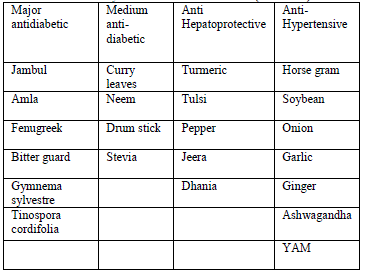 |
 |
| Invitro Porcine Pancreatic Alpha-Amylase inhibition assay |
| DNS (3, 5 Dinitrosalicylic acid) assay:The determination of α-Amylase inhibition was carried out by quantifying the reducing sugar (glucose equivalent) liberated under the assay condition. The enzyme inhibitory activity was expressed as decrease in units of glucose liberated [15]. Plant extract concentrations ranging from 10-100μg were incubated with 1ml of 1unit PPA Enzyme for 30minnutes at 37°C. After incubation 1ml of 1% buffered starch was added and the mixture was further incubated for 10minutes at room temperature. The reaction was stopped by adding 1ml DNS reagent and the contents were heated in boiling water bath for 5minutes. Blank was prepared without plant extract and enzyme which was replaced with equal quantity of 0.1M phosphate buffer. Control representing 100% enzyme activity without plant extract was also included. The absorbance was read at 540nm using UV Spectrophotometer. The reducing sugar released from starch was estimated as glucose equivalent from standard graph. Standard antidiabetic drug Acarbose was used as positive control.The antidiabetic property was determined through inhibition of alpha amylase which was expressed as percentage of inhibition and calculated by following equation: |
| % Inhibition = Absorbance of control – Absorbance of test/Absorbance of control *100 |
| IC50 values of Acarbose and PHF1 extracts of different solvents were determined from plots of percentage inhibition versus concentration (μg/ml). IC50 value is defined as the concentration of extract required to inhibit 50% of PPA (Porcine Pancreatic Alpha-Amylase) activity. |
| Qualitative phytochemical analysis: |
| Extracts were tested for the presence of alkaloids, tannins, flavonoids, polyphenols, saponins etc using standard procedures. [16]. 1:10 dilution of extracts was prepared and then subjected to phytochemical screening. |
| GC-MS Analysis: |
| PHF1 Hot water extract which showed maximum inhibition (88.23%) on PPA activity was subjected to GCMS equipped with Rtx-5 capillary column (30m x 0.25mm ID). Helium was the carrier gas with flow rate of 1ml/min, the injector mode – split ratio 5.0, the injection volume 1μl, the temperature program used is as follows: 150ºC then increased to 300ºC held at 300ºC for 15.00 min. The identification of components was based on the comparison of their mass spectra with those of NIST-WILEY Library. |
RESULTS |
| In the present study Polyherbal formulation(PHF1 ) extracts of seven different organic solvents exhibited significant reduction in alpha-amylase activity. Acarbose standard antidiabetic drug which was used as positive control at concentrations 10-100μg/ml showed PPA inhibitory activity from 18.75% to 58.60% with an IC50 value of 83.34μg/ml [Table 4, figure1].PHF1 hot water extract at concentration10-100μg/ml showed maximum inhibitory effects on Alpha- Amylase activity from 23.5% to 88.23% with an IC50 value of 40μg/ml and 28μg/ml respectively [Table5, figure 2]. PHF1 Ethanolic, cold water, Isopropanol, Petroleum ether, Chloroform and Methyl tertiary butyl ether extracts at concentrations 10-100μg/ml showed moderate inhibitory effects on Alpha-Amylase activity from 17.6% to 70%, 26.4% to 61.76%, 29.4% to 55.8%, 41.17% to 57.9%, 18.2% to 52.9% and 11.7% to 40% respectively with an IC50 value of 72μg/ml,70μg/ml,74μg/ml,60μg/ml,90μg/ml and 96μg/ml[Table 6, figure 4 to 9]. Qualitative phytochemical screening revealed presence of Glycosides, steroids, Triterpenoids, phenols, tannins and saponins [Table 8]. Results pertaining to GCMS analysis are given in [Table 9]. |
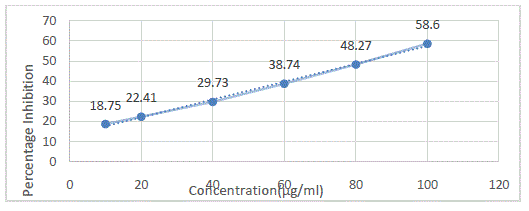 |
 |
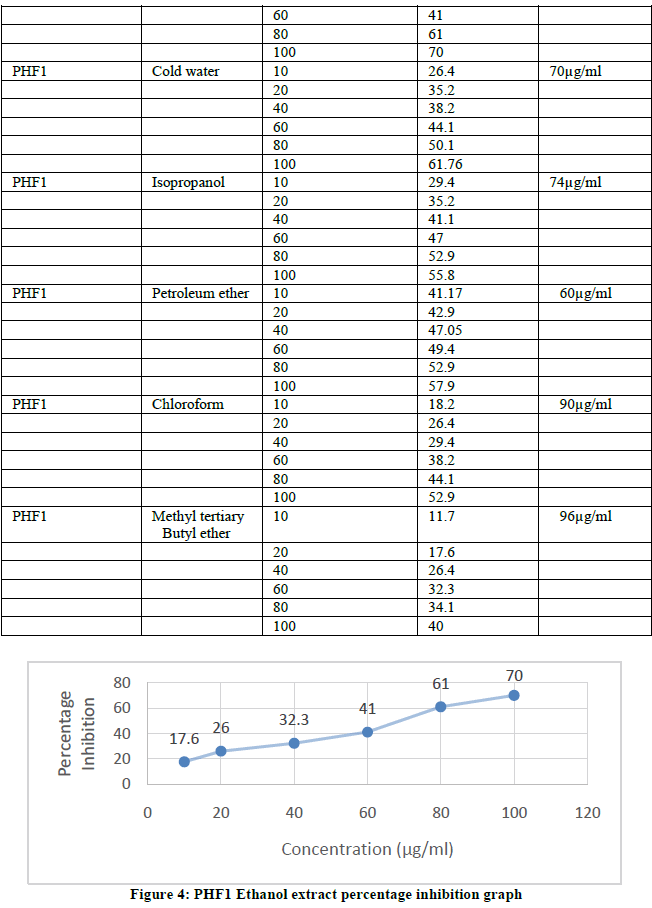 |
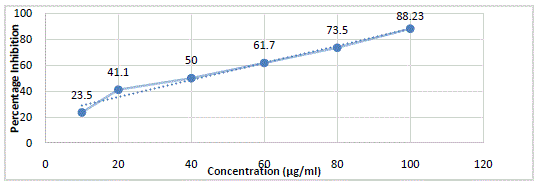 |
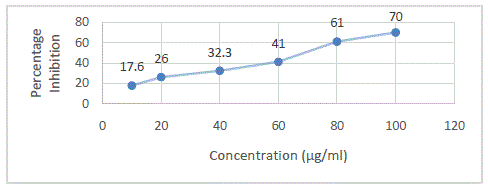 |
 |
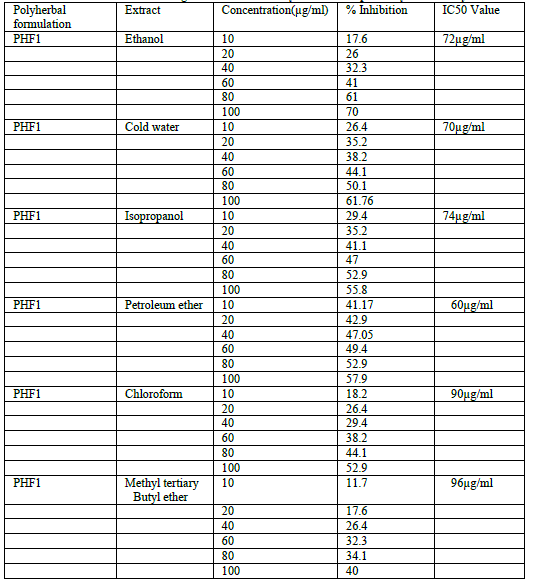 |
DISCUSSION |
| In this study PHF1 was evaluated for their respective alpha-amylase inhibitory activity. The result indicates that PHF1 hot water extract showed maximum inhibitory effect on Alpha-Amylase with an IC50 value 40μg/ml and 28μg/ml which is less than Acarbose suggesting that PHF1 Hot water extract could be a promising lead extract. This is due the presence of phytochemicals that acts as potential alpha-amylase inhibitors such as Glycosides, steroids, phenols, triterpenoids etc.To analyze which phytochemical compound in PHF1 Hot water extract was responsible to inhibit the enzyme alpha-amylase, sample was subjected to GC-MS.It was noted that in PHF1 Hot water extract, 19 major compounds were detected which is shown in [Table 9].Thus due to existence of Hexadecanoic acid, 9,12-Octadecadienoic acid(Z,Z)-Linoleinic acid,lupeol,Phytol and other compounds PHF1 Hot water extract showed maximum inhibitory activity on Alpha-Amylase activity.It is well known that certain flavonoids and phytol exhibit hypoglycemic activity and is also known for their ability of beta-cell regeneration of pancreas [17, 18]. Sterols have also shown to decrease blood sugar in experimental animal models [19]. Thus the significant anti-diabetic effect of the extract may be due to the presence of flavonoids, Triterpene, steroids, palmitic acid ester etc.The activities of some phytochemicals with compound nature of flavonoids, palmitic acid (hexadecanoic acid ethyl ester and nhexadecanoic acid), unsaturated fatty acid and linolenic acid (docosatetranoic acid and octadecatrienoic acid) as antimicrobial, anti-inflammatory, antioxidant hypocholesterlemic, cancer preventive, hepatoprotective, antiarthritic, antihistimic, antieczimic and anticoronary [20]. Oral administrations of Grewiaum bellifera extract at 250mg and 500 mg / kg body wt for 28days showed decrease in fasting blood when compared with that of standard drug Glibenclamide due to the presence of Triterpene, Asarone, Diterpene, linoleic acid ester, Flavonoid compound, Steroid compound which was analyzed in GC-MS [21]. Isopropanol extract of Ocimum tenuiflorum, Morus Alba and Linum usitatissimumshowed greater than 50% PPA inhibitory activity, potent alpha-amylase inhibitor responsible for this inhibition was identified by GC-MS analysis which indicated that Camphene in Ocimum tenuiflorum, Hexadeconoic acid and 9, 12-Octadecadienic acid in Morus Alba and 2-Cyclopentene-1-undecanoic acid in Linum usitatissimum were the major compounds responsible for maximum inhibitory activity [22]. Syzygium aromaticum-derived oleanolic acid (OA) inhibits alpha-amylase and alpha-glycosidase enzyme with an IC50 value of 62.11μg/ml less when compared with IC50 value of Acarbose 80.25μg/ml, thereby decreasing the absorption of glucose across the small intestine [23]. Ethanolic extract of Allium sativum and Allium cepa has been reported for alpha-amylase inhibitory effects with an IC50 value of 17.95 and 16.36mg/ml [24]. Ethanol extract of Mangifera indica, Azadirachta indica and petroleum ether extract of Murraya koenigii showed maximum percentage inhibition on alpha-amylase activity with IC50 value of 37.86μg/ml, 62.99μg/ml and 59μg/ml [25]. Acalypha indica is used in Indian traditional medicinal system and it is reported that chloroform and hexane extracts to possess alpha-amylase activity [26].Omega-3-fatty acids have been found to be essential for normal growth and development and may play an important role in the prevention and treatment of coronary artery disease, hypertension, diabetes, and arthritis, other inflammatory and auto immune disorders and cancer [27].The present study indicates that hot water extracts of Polyherbal formulation(PHF1 ) composed of twenty medicinal plants can be useful in management of postprandial hyperglycemia because the hot water extract possess important bioactive compounds which acts as alpha-amylase inhibitors, thus lowering PPHG (Post prandial hyperglycemia) level in type II Diabetic patients. |
CONCLUSION |
| Indian Ayurvedic system from ancient times has used the medicinal plants to treat diabetes. PHF used in our study is composed of a plant which has hypoglycemic property; formulations were tested for anti-diabetic property by subjecting the extracts of PHF to Alpha-Amylase inhibition assays. One of the mechanism to control blood sugar level in typeII Diabetic patients is to lower the PPHG level. This can be targeted by reducing the activity of Alpha-Amylase enzyme which is responsible for conversion of starch to reducing sugar. Thus the Results obtained suggests that PHF1 Hot water extract is said to have more than five bioactive compounds which inhibits the activity of alpha-amylase enzymetherapy can be used as an Oral hypoglycemic agent to control PPHG level. Future Study: Antioxidant property of PHF1 can be evaluated as well as in vivo studies need to be performed to confirm antidiabetic and antioxidant property of PHF. |
References |
|